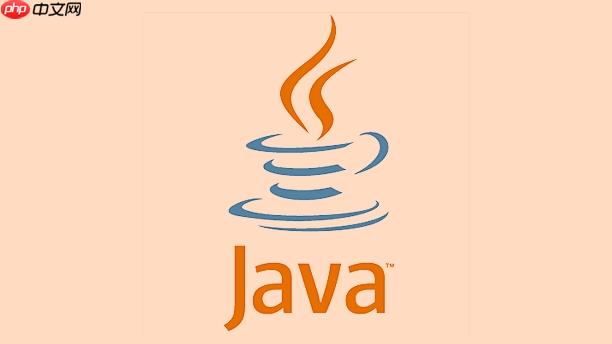this是Java中指向当前对象的引用,用于解决实例变量与局部变量的命名冲突(如this.name = name)、实现构造器链调用(this()必须为第一条语句)以及将当前对象作为参数传递,增强代码可读性与维护性。

在Java中,
this
this
理解
this
消除歧义: 这是最常见的场景。当一个实例变量(成员变量)与一个局部变量或方法参数同名时,
this
public class Person {
String name; // 实例变量
public Person(String name) { // name 是构造器参数
this.name = name; // 使用 this.name 明确指定是实例变量 name
}
public void greet(String name) { // name 是方法参数
System.out.println("Hello, " + this.name + "!"); // 依然是实例变量 name
System.out.println("But you called me with: " + name); // 这是方法参数 name
}
}你看,
this.name
Person
name
立即学习“Java免费学习笔记(深入)”;
构造器链(Constructor Chaining): 在一个类的构造器内部,你可以使用
this()
this(arguments)
public class Product {
String id;
String name;
double price;
// 基础构造器
public Product(String id, String name, double price) {
this.id = id;
this.name = name;
this.price = price;
System.out.println("Product created: " + name);
}
// 另一个构造器,只提供ID和名称,价格默认为0.0
public Product(String id, String name) {
this(id, name, 0.0); // 调用上面的三参数构造器
System.out.println("Product created with default price.");
}
// 还有一个构造器,只提供ID
public Product(String id) {
this(id, "Unnamed Product"); // 调用两参数构造器,它又会调用三参数构造器
System.out.println("Product created with minimal info.");
}
}这里有个严格的规则:
this()
将当前对象作为参数传递: 有时候,你需要将当前对象实例传递给另一个方法或另一个类的对象进行操作。这时,
this
public class EventPublisher {
public void publish(MyEvent event) {
System.out.println("Publishing event from: " + event.getSource().getClass().getSimpleName());
// ... 实际的发布逻辑
}
}
public class MyEvent {
private Object source;
public MyEvent(Object source) {
this.source = source;
}
public Object getSource() {
return source;
}
}
public class Worker {
private EventPublisher publisher = new EventPublisher();
public void doWork() {
// ... 正在做一些工作
System.out.println("Worker " + this.getClass().getSimpleName() + " is doing work.");
// 工作完成后,发布一个事件,并把自己(当前Worker对象)作为事件源
MyEvent completionEvent = new MyEvent(this); // 将当前Worker对象作为事件源
publisher.publish(completionEvent);
}
}在我看来,这种用法特别能体现面向对象中“对象间协作”的思想,一个对象知道如何把自己介绍给别的对象。
this
这其实是一个关于“自我意识”和“上下文”的问题。在Java这样的面向对象语言里,每个对象都是一个独立的个体,有自己的状态(实例变量)和行为(方法)。当你在一个对象的方法内部编写代码时,你是在这个对象的“内部视角”下进行操作。
想象一下,你正在写一份关于你自己的报告。如果你说“我的名字是…”,听众自然知道你在说你自己的名字。但在代码里,当一个方法参数的名字恰好和你的实例变量名字一样时,比如
public void setName(String name)
name
name
这时候,
this
name
this.age = someValue
age
this
this()
this(arguments)
它的工作原理是这样的:当你在一个构造器内部使用
this(...)
核心规则前面提到了:
this()
this()
这种机制带来的好处显而易见:减少了代码重复,提高了代码的可维护性。想象一下,如果你有五个构造器,每个都需要初始化十个字段,如果没有构造器链,你可能要在每个构造器里重复写这十行代码。有了
this()
this
super
this
super
this
this.variableName
this.methodName()
this()
this(arguments)
this
super
super.variableName
super.methodName()
super()
super(arguments)
super
在我看来,它们最核心的区别在于作用域和继承层次。
this
super
举个例子:
class Animal {
String name = "Generic Animal";
public Animal() {
System.out.println("Animal constructor called.");
}
public void eat() {
System.out.println(name + " is eating.");
}
}
class Dog extends Animal {
String name = "Doggy"; // 隐藏了父类的 name 变量
public Dog() {
// super(); // 隐式调用,如果父类有无参构造器,这行可以省略
System.out.println("Dog constructor called.");
}
@Override
public void eat() {
System.out.println(this.name + " is happily eating."); // 访问 Dog 类的 name
super.eat(); // 调用 Animal 类的 eat 方法,会打印 "Generic Animal is eating."
}
public void displayNames() {
System.out.println("My name (this.name): " + this.name);
System.out.println("My parent's name (super.name): " + super.name);
}
}从上面的
Dog
this.name
Dog
name
super.name
Animal
name
eat()
this.name
super.eat()
以上就是如何在Java中使用this引用当前对象的详细内容,更多请关注php中文网其它相关文章!

每个人都需要一台速度更快、更稳定的 PC。随着时间的推移,垃圾文件、旧注册表数据和不必要的后台进程会占用资源并降低性能。幸运的是,许多工具可以让 Windows 保持平稳运行。

Copyright 2014-2025 https://www.php.cn/ All Rights Reserved | php.cn | 湘ICP备2023035733号